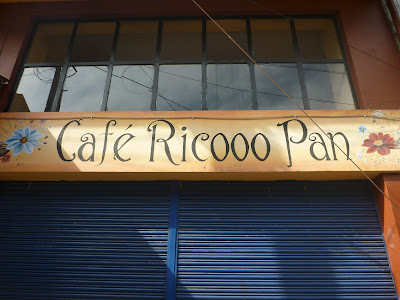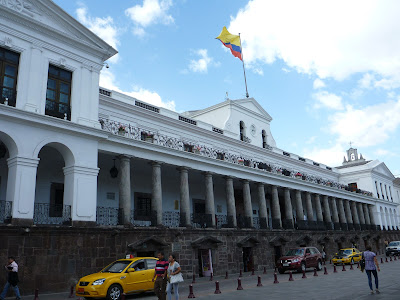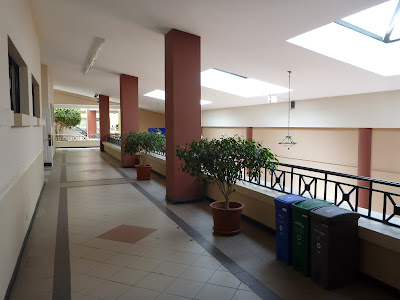There were also smurfs everywhere. On candy, cookies, signs, and in doorways, like this creepy girl whose hand got broken off shortly before we left:
I spent most of Saturday shopping through the little tourist joints and wandering around the city with friends. Most of the shops sold the same sort of thing, colorful bags, clothing, headbands, alpaca sweaters, keychains, etc.
Saturday evening everyone went out for dinner, had a few drinks in the pub at the hostel, got frozen bananas for dessert, and went dancing at a place called the Leprechaun Bar. It was fun, but I wanted to be up early to do more stuff in the city the next day, so I ditched at about 12:30.
Sunday, a friend and I went for a ride in one of Banos' famous tarabitas, little rickety metal baskets that run back and forth over river canyons.
After the ride finished, I snuck inside the control room and asked the guy about the motor apparatus. Turns out it was just your average car motor that they'd hooked up to a pulley apparatus. Safety standards are a little looser here...
They look like giant rats but they're actually guinea pigs all stretched out.
Whole pigs are almost $20, so we decided to get two single serving plates, which include about a quarter of one cuy, potatoes, and rice for $3.50. The cuy was pretty tasty, although actually not very meaty, and I was surprised that they had become a staple food when there was so little meat on their bones. I suppose breeding prolifically makes up for it...
The only disconcerting thing about the cuy place was that it didn't have a bathroom, so we couldn't wash our hands before eating. We'd been touching all sorts of nasty stuff all day long, including the tarabita, and naturally you eat cuy with your hands, so we were a little worried that we were going to get sick, but nothing serious came of it.
After the cuy, we walked around town a little bit and I hiked up a ridge to the neon cross that gets lit up above the city at night. None of the houses on the ridge and the hills leading up to it have electricity, so at night the cross looks like it's floating in the middle of a black sky.
On top of the hill, there was lots of agriculture, including an orchard of tomate de árbol.
Here's some more of the quirky cafes and other stuff around Banos:
The rhino train.
Cafe Blah Blah.
Inside Cafe Blah Blah.
Cafe Ricooo Pan.
The TV remote salesman.
























.jpg)
.jpg)
.jpg)
















